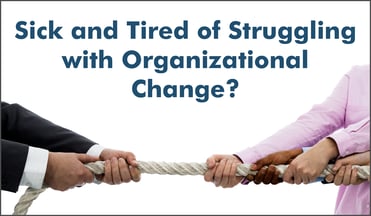
After more than 25 years in corrections leading teams through change, I can tell you – I’m sick and tired of struggling with it! And I know I’m not alone. I consult with agencies every day that are struggling through organizational change.
It doesn’t have to be this way.
There are two strategies that when used properly help us get out ahead of change and influence it in a way that makes leading through change much easier - even as much as 10 times easier!
“How?!” You say.
“Lay it on me!”
Let’s lay some groundwork.
Let’s first think about what causes the struggle. Why do employees resist change?
There are many of reasons why employees resist change. Here are just a few:
- The risk of change is perceived as being greater than the risk of not changing
- They are afraid they lack the capability to change
- The employee feels overloaded and overwhelmed
- Employees may have a healthy skepticism about new ideas
- Employees fear you have a hidden agenda
- The employee anticipates a loss of status or a lessened quality of life
There is a common thread in this list – Fear.
People are afraid of change.
They fear the loss of control. They fear the uncertainty of it all. We all crave certainty; we’re built that way. Our brains reward us with dopamine when we have certainty whereas uncertainty causes our brains to kick in a chemical called cortisol resulting in high levels of stress and anxiety.
High levels of stress actually inhibit learning and lowers functioning. In his book “Brain Rules”, Dr. John Medina points to one study that showed adults with high levels of stress performed 50 percent worse on tests involving memory and problem solving than adults with low levels of stress.
Sound familiar?
Things are going pretty well - no major problems. Then you decide that you need to make a change. You think it’s a positive change. It’s needed. It will help your operation improve. Your launch of the new change is met with resistance and shock. You realize the team doesn’t understand the need for the change. As you set about trying to convince them, the shock and resistance turn into anger and frustration. Then the whole project slows down to a crawl. You deal with it.
The project eventually gets moving, but what a struggle!
Why does this happen?
Because once fear and stress take hold, they lower learning and functioning. They slow down and prolong the change process.
The key then is to be proactive and manage change in such a way that we reduce the fear and stress. This speeds up the change process and makes it so much easier!
Now I’m Going to Lay it on You!
There are two strategies for being proactive during times of change.
Strategy #1: Build Personal Motivation
Change is hard!
If we’re honest with ourselves, most of us will admit that we just aren’t that motivated to do things that are uncomfortable and stressful. That’s why change is required. If we were motivated to do these difficult things, we would have done them already.
How do you motivate an employee to embrace this new change project?
Money? It’s highly overrated. Money is not even close to being the top motivator for most people. Throwing a bonus at them may juice them up for the change in the short run, but the initial excitement will wear thin quickly.
Other tangible rewards? Recognition. Awards. Time off. Trips. Food. All of these can be good rewards if they are meaningful to the employee and used for rewarding specific behaviors. But for building personal motivation they share the same problem as money.
They are all extrinsic motivators.
Extrinsic motivators are a “Carrot and Stick” approach. These are what Stephen Covey called “the great jackass theory of human motivation.” It’s an attempt to coerce the employee to buy into this change that we’re selling.
When we use these methods, we’re basically using our authority to force someone to change, albeit sugar coating it with money and trinkets.
Building personal motivation requires we tap into the employee’s intrinsic motivation, as we’ve learned from our EBP implementation. Does this sound familiar to anyone who is managing a client caseload using MI (Motivational Interviewing) and other EBP techniques? We have to link this change to the employee’s personal and professional values. This gives the change real meaning to the employee.
That’s a motivation we can build on!
Let’s say you’re going to roll out a new software system for the department. That’s a change project for sure, but one that has the potential to make substantial improvements to everyone’s daily lives. Case managers’ interactions with clients will be more personal due to so much saved time. Security staff processes will be more efficient and streamlined. These changes, no matter how amazing for your community corrections agency, may seem scary to some employees.
You want to build personal motivation. You know that one of your key employees is very passionate about being in this business to change lives. To build personal motivation you need to show the employee how this new software system will help them be better at changing lives. When you’ve done that you’ve tapped into intrinsic motivation.
Before we move on there are two important things to remember about building personal motivation:
-
It must be personal and be done one-on-one. This is not the time for the leader to stand in front of the team trying to rev them up; it’s no pep rally. Building personal motivation requires a personal touch.
-
A leader must connect. This is all about relationships. The leader has to build an environment where instead of employees following them because of their title, but they follow the leader because they want to follow. Employee engagement begins with a personal emotional connection with the leader.
Strategy #2: Show Them They Can Do It
Motivation is not enough by itself.
Your staff may be totally bought into your leadership and you’ve found a way to connect a proposed change to their values. They’re fired up! But if we stop there we’ve only addressed part of their fears.
The other part is “Can I do this?” “Can I handle this?” We have to show them that they can do it.
A large part of the struggle with change is actually the “how.” We resist, in part, because we’re not sure how to do this new change. We’re afraid of failing and embarrassing ourselves.
“What if I’m not able to learn this new software?”
“What if the new leadership requires things to be done in a way I can’t do?”
“This MI stuff confuses me and the scale up looks really challenging. What if I fail?”
There are a number of ways to show employees that they can do it.
-
Let them put their hands on it and try it. Sometimes just “kicking the tires” can ease a lot of fears. For example, let them play with the software a bit.
-
Enlist the help of some of your superstar players to be champions of the change. We all have these superstars. When they realize they can do it, enlist them to show their peers.
-
Train, Train, Train. Enough said on that one!
-
Create a community of practice, a peer-led group empowered by management to meet on a regular basis and practice new skills. It’s a powerful concept that provides peer support and expands the reach of your training.
-
Remove obstacles and barriers to success. Sometimes tools, equipment, policies and procedures can get in the way. Employees see obstacles that you may not. When we remove those obstacles they can see a clear path to success.
Are you sick and tired of struggling with organizational change?
Be proactive. Get ahead of the change. Build personal motivation and show employees that they can do it.
When you use these strategies change becomes much easier. The folks over at VitalSmarts.com took these strategies and expanded them into six factors: Personal, Social and Structural Motivation and Personal, Social, and Structural Ability. Their research shows that organizations that combine four to six of these factors are up to ten times more successful at their change projects.
Organizational change can be much easier if you use the right strategies!
A note from the author: I can’t wait to share more pearls of wisdom that I’ve gleaned over the years through my relationship with CorrectTech! Keep in touch as I continue to guest write and work with CorrectTech in their goal of making community corrections practitioners’ lives easier.


